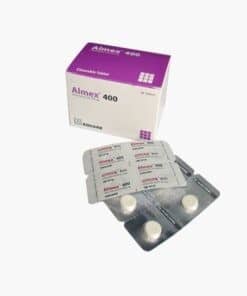Subtotal: ৳ 90.00
Amilin | 10 mg | Tablet | 14 pcs
৳ 11.90
Brand Name: Amilin Tablet
Generic: Amitriptyline hydrochloride
10 mg
Manufacturer: Opsonin Pharma Ltd.
Unit Price: ৳ 0.85 (112’s pack: ৳ 95.45)
Indications
Therapeutic Class
Pharmacology
Amitriptyline HCl is an antidepressant with sedative effects. Its mechanism of action in man is not known. It is not a monoamine oxidase inhibitor and it does not act primarily by stimulation of the central nervous system.
Amitriptyline inhibits the membrane pump mechanism responsible for uptake of norepinephrine and serotonin in adrenergic and serotonergic neurons. Pharmacologically, this action may potentiate or prolong neuronal activity since reuptake of these biogenic amines is important physiologically in terminating transmitting activity. This interference with reuptake of norepinephrine and/or serotonin is believed by some to underlie the antidepressant activity of Amitriptyline.
Dosage & Administration
Depression :
- Adults: Initially 50-70 mg a day in divided dose or as a single dose at night at bed time.
- Elderly and adolescents: 25-50 mg daily in divided doses or as single dose at bed time. Dose can be increased gradually as necessary to a maximum of 150-200 mg. Usual maintenance dose is 50-100 mg daily.
Nocturnal enuresis:
- 6-10 years: 10-20 mg at bed time.
- 11-16 years: 25-50 mg at bed time for up to 3 months and gradually withdrawn.
Interaction
Monoamine oxidase inhibitors can potentiate the effects of Amitriptyline.
Anticholinergic agents: Amitriptylin should not be given with symptomatic agents such as adrenaline, epinephrine, isoprenaline, noradrenaline.
CNS depressant: Amitriptyline may enhance the response to alcohol, barbiturates.
Cemitidine: Cemitidine is reported to reduce hepatic metabolism of certain tricyclic antidepressants.
Contraindications
Side Effects
- Cardiovascular reactions: Hypotension, syncope, postural hypotension, hypertension, tachycardia, palpitations, myocardial infarction, arrythmias, and heart block stroke.
- CNS and neuromuscular: Confusional states, disturbed concentration disorientation, delusions, and hallucinations.
- Anticholinergic: Dry mouth, blurred vision, mydriasis, increased intraoccular pressure, hyperplasia.
- Allergic: Skin rash, urticaria, and photosensitization.
- Haematological: Bone-marrow depression including agranulocytosis, leukopenia, eosinophilia, and thrombocytopenia.
- Gastrointestinal: Nausea, epigastric distress, vomiting anorexia, diarrhoea.
- Endocrine: Testicular swelling, gynaecomastia; breast enlargement, galactorrhoea.
- Other reaction: Dizziness, weakness, fatigue, headache, weight loss
Pregnancy & Lactation
Pregnancy Category C. Amitriptyline is not recommended during pregnancy, especially during the first and third trimester because the safety of Amitriptyline has not been established yet.
Amitriptyline is detectable in breast milk. Because of the serious adverse reactions in infants from Amitriptyline, a decision should be made whether to continue breast feeding or discontinue the drug
Precautions & Warnings
Schizophrenic patients may develop increased symptoms of psychosis; patients with paranoid symptomatology may have an exaggeration of such symptoms. Depressed patients, particularly those with known manic-depressive illness, may experience a shift to mania or hypomania. In these circumstances the dose of Amitriptyline may be reduced or a major tranquilizer such as perphenazine may be administered concurrently.
The possibility of suicide in depressed patients remains until significant remission occurs. Potentially suicidal patients should not have access to large quantities of this drug. Prescriptions should be written for the smallest amount feasible.
Concurrent administration of Amitriptyline hydrochloride and electroshock therapy may increase the hazards associated with such therapy. Such treatment should be limited to patients for whom it is essential.
When possible, the drug should be discontinued several days before elective surgery. Both elevation and lowering of blood sugar levels have been reported. Amitriptyline hydrochloride should be used with caution in patients with impaired liver function.
Storage Conditions
| Generic Name | Amitriptyline hydrochloride |
|---|---|
| Size | 10 mg |
Only logged in customers who have purchased this product may leave a review.












Reviews
There are no reviews yet.